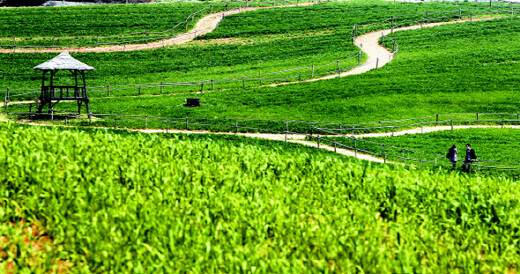hankyoreh
Links to other country sites 다른 나라 사이트 링크
Urbanites returning to rural areas, study shows

By Kim Hyun-dai, Senior Staff Writer
More than ten thousand people per year are moving from urban areas back to agricultural communities, a study shows.
The Ministry for Food, Agriculture, Forestry and Fisheries (MIFAFF) announced Friday that a total of 4,067 families and 9,732 people returned to farming and their home villages in 2010. Following a slight increase between 2001 and 2008, which saw a rise from 880 to 2,218 families, the returnee farmer population nearly doubled in 2009 to 4,080 households in 2009 and stayed in the 4,000-family range during 2010 as well. Analysts are predicting a population of 10 thousand people annually moving to agricultural communities in the years ahead.
The political unit that saw the largest increase was North Gyeongsang Province, with 1,112 families, followed by South Jeolla Province with 768 families, North Jeolla Province with 611 families, and South Gyeongsang Province with 535 families. Two-thirds of those moving were individuals in their forties and fifties, respectively 30.2 percent and 35.8 percent. Nearly half of the returnees, or 47.1 percent, were cultivating ordinary rice paddies, followed by 17.8 percent growing fruit, 10.9 percent engaged in facility horticulture, and 7.7 percent practicing livestock farming.
As reasons for the increase in the returnee farmer population, experts cited factors such as the retirement of the Baby Boom generation, a growing trend of respect for life and the ecosystem, increased concerns about food shortages, and policy benefits for returnee farmers.
The rise in the returnee farmer population has been accompanied by an increase in the popularity of schools for these farmers, as instituted by organizations such as Refarm and the Rural Development Administration. As the number of students has grown since the foreign exchange crisis, schools are increasing their class sizes and still having people on the waiting list. The Gwangju/South Jeolla Province returnee farming school increased the size of its class from 30 to 70 over a period of two to three years and has around ten people on its waiting list for the spring course. The South Chungcheong Province returnee farming school has seen an increase in its class roster from 35 people in 2010 to 58 this year. Some one hundred students attended a returnee farmer college in the greater Seoul area organized by the RDA, and a total of 63 people have registered this year, including company workers, professors, schoolteachers, and cooks in their forties to sixties.
Most cities and counties concerned about falling population are offering around 30 million won in support to returnee farmers over a period of one to two years, including 5 million won for farmhouse reconstruction, a 7.2 million won farming intern allowance for half a year, and 20 million won for equipment installation expenses. Policy funds of around 2 to 3 percent are also loaned out at low interest rates for the different areas.
Please direct questions or comments to [englishhani@hani.co.kr]
Editorial・opinion
![[Column] Has Korea, too, crossed the Rubicon on China? [Column] Has Korea, too, crossed the Rubicon on China?](https://flexible.img.hani.co.kr/flexible/normal/500/300/imgdb/original/2024/0419/9317135153409185.jpg) [Column] Has Korea, too, crossed the Rubicon on China?
[Column] Has Korea, too, crossed the Rubicon on China?![[Correspondent’s column] In Japan’s alliance with US, echoes of its past alliances with UK [Correspondent’s column] In Japan’s alliance with US, echoes of its past alliances with UK](https://flexible.img.hani.co.kr/flexible/normal/500/300/imgdb/original/2024/0419/2317135166563519.jpg) [Correspondent’s column] In Japan’s alliance with US, echoes of its past alliances with UK
[Correspondent’s column] In Japan’s alliance with US, echoes of its past alliances with UK- [Editorial] Does Yoon think the Korean public is wrong?
- [Editorial] As it bolsters its alliance with US, Japan must be accountable for past
- [Guest essay] Amending the Constitution is Yoon’s key to leaving office in public’s good graces
- [Editorial] 10 years on, lessons of Sewol tragedy must never be forgotten
- [Column] A death blow to Korea’s prosecutor politics
- [Correspondent’s column] The US and the end of Japanese pacifism
- [Guest essay] How Korea turned its trainee doctors into monsters
- [Guest essay] As someone who helped forge Seoul-Moscow ties, their status today troubles me
Most viewed articles
- 1[Column] The clock is ticking for Korea’s first lady
- 2Hong Se-hwa, voice for tolerance whose memoir of exile touched a chord, dies at 76
- 3After 2 months of delayed, denied medical care, Koreans worry worst may be yet to come
- 4[Column] Has Korea, too, crossed the Rubicon on China?
- 5[Correspondent’s column] In Japan’s alliance with US, echoes of its past alliances with UK
- 6US overtakes China as Korea’s top export market, prompting trade sanction jitters
- 7Samsung barricades office as unionized workers strike for better conditions
- 8All eyes on Xiaomi after it pulls off EV that Apple couldn’t
- 9More South Koreans, particularly the young, are leaving their religions
- 10John Linton, descendant of US missionaries and naturalized Korean citizen, to lead PPP’s reform effo